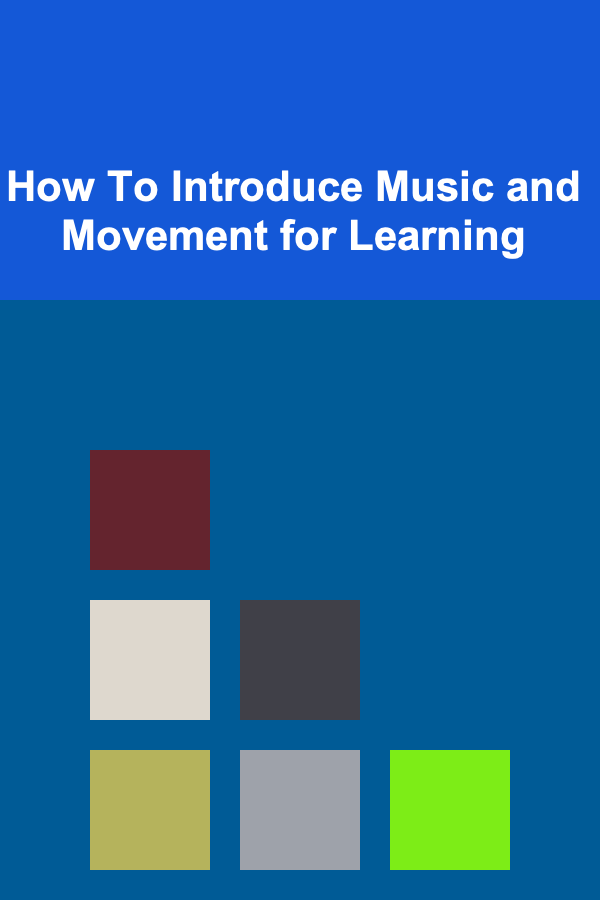
How to Integrate Your Blog Planner with Your Social Media Strategy
ebook include PDF & Audio bundle (Micro Guide)
$12.99$5.99
Limited Time Offer! Order within the next:
Not available at this time

Creating high-quality content for your blog is only part of the equation for successful online marketing. If you want to maximize the reach and engagement of your blog posts, you need to integrate your blog planner with your social media strategy. A well-thought-out social media plan can help amplify your blog content, drive more traffic to your site, and grow your audience over time.
In this article, we will explore the steps involved in integrating your blog planner with your social media strategy. From setting clear goals to leveraging content repurposing, we'll guide you through the process of creating a seamless connection between your blog and social media, ultimately leading to improved content performance and engagement.
Set Clear and Aligned Goals
Before you start integrating your blog planner with your social media strategy, it's essential to establish clear goals. These goals will serve as a roadmap for both your blogging and social media efforts, ensuring they are aligned and working toward a common objective.
Define Your Blog Goals
Your blog goals might include:
- Increasing website traffic
- Building brand authority and trust
- Generating leads or sales
- Establishing thought leadership in your niche
- Growing a dedicated audience
Define Your Social Media Goals
On the social media side, your goals might include:
- Growing your social media following
- Increasing engagement (likes, comments, shares)
- Driving traffic to your blog from social platforms
- Promoting specific blog posts or campaigns
- Enhancing brand awareness and reach
Align Both Sets of Goals
Once you've defined your blog and social media goals, make sure they align. For example, if your blog goal is to increase website traffic, one of your social media goals might be to drive more visitors to your blog through sharing blog posts or promoting your content on multiple platforms.
By aligning both sets of goals, you ensure that your blog content will seamlessly tie into your social media strategy, maximizing both your efforts.
Create a Content Calendar for Both Blog and Social Media
A content calendar is a key tool for integrating your blog planner with your social media strategy. It helps you plan, schedule, and organize both blog posts and social media content in a way that ensures consistency and prevents overlap.
Plan Your Blog Content
Start by creating a blog content calendar. Plan out your blog posts for the next few months, considering relevant topics, seasonal trends, and audience preferences. Your blog planner should include:
- Titles of upcoming blog posts
- Deadlines for writing, editing, and publishing
- A brief outline or content idea for each post
- Target keywords and SEO strategies
Plan Your Social Media Content
Once you have your blog content calendar, align your social media content with it. Plan social media posts that will promote or complement your blog content. Your social media content calendar should include:
- Social media platforms to focus on (Instagram, Twitter, Facebook, Pinterest, etc.)
- Posts that will link directly to new or upcoming blog content
- Engagement-focused posts (questions, polls, discussions) to boost interaction
- Repurposed content from your blog (quotes, snippets, visuals)
By creating a content calendar for both your blog and social media, you ensure that you're consistently sharing content across all channels. Additionally, this helps you avoid creating content in isolation and encourages a more cohesive approach to your online presence.
Repurpose Blog Content for Social Media
Repurposing your blog content for social media is an efficient way to get more mileage out of each blog post. Not only does it help maintain a consistent flow of content on your social media channels, but it also drives traffic back to your blog. Here are several ways to repurpose your blog content for social media:
Create Snippets and Quotes
Take compelling quotes, statistics, or excerpts from your blog posts and turn them into shareable graphics or text posts for social media. These snippets are attention-grabbing and can spark conversation around your blog content.
Share Blog Highlights
Instead of posting the entire blog post, share the main takeaways or highlights in a condensed format on social media. Include a call to action (CTA) to encourage people to click through to your blog for the full post.
Design Visual Content
Transform blog content into visual formats such as infographics, slideshows, or videos. Platforms like Instagram, Pinterest, and LinkedIn thrive on visual content, and these formats are highly shareable.
Share Long-Form Content in Segments
If you write long-form blog posts, break them down into bite-sized social media posts. Each section or key point of the post can be turned into an individual social media post that still drives traffic to the full article.
Use Stories and Reels
For Instagram and Facebook, stories and reels provide an excellent opportunity to share behind-the-scenes content, quick tips, or highlights from your blog posts. These formats are perfect for providing immediate value and linking to your full blog post.
By repurposing your blog content into different formats, you increase the visibility of your posts and create more opportunities for engagement across social media platforms.
Leverage Social Media Scheduling Tools
Consistency is key when it comes to social media marketing. To keep your content strategy organized and efficient, use social media scheduling tools to schedule your posts in advance. This allows you to focus on creating high-quality content rather than scrambling to post in real-time.
Popular Social Media Scheduling Tools:
- Buffer: A comprehensive social media scheduling tool that allows you to schedule and analyze posts across multiple platforms.
- Hootsuite: Hootsuite is another popular tool for scheduling social media posts, monitoring conversations, and tracking performance.
- Later: Later specializes in visual content scheduling, making it a great tool for platforms like Instagram and Pinterest.
- Sprout Social: Sprout Social offers scheduling along with detailed analytics, allowing you to refine your strategy based on performance.
Benefits of Scheduling:
- Time-Saving: Scheduling posts in advance saves time and ensures your social media content is posted consistently, even when you're busy with other tasks.
- Strategic Timing: Scheduling tools allow you to post at optimal times, ensuring maximum visibility and engagement for your blog content.
- Content Cohesion: By scheduling posts ahead of time, you can plan and create content in a cohesive way that aligns with both your blog and social media goals.
Engage with Your Audience
Engagement is a two-way street. It's not enough to simply post your blog content on social media; you need to actively engage with your audience to build relationships and trust. Engaging with your audience encourages interaction and feedback, which in turn increases the visibility of your posts and helps build a loyal following.
How to Engage:
- Respond to Comments: Take the time to reply to comments on your blog posts and social media. Engaging in conversation creates a more interactive experience for your audience.
- Ask Questions: Use social media posts to ask questions or solicit feedback about your blog content. This can increase engagement and provide insights into what your audience wants to read about next.
- Host Contests or Giveaways: Running contests or giveaways on social media can boost engagement and generate interest in your blog content.
- Use Polls and Quizzes: On platforms like Instagram or Twitter, polls and quizzes can be a fun way to engage your audience and learn more about their preferences.
By engaging with your audience on both your blog and social media, you create a sense of community that can encourage readers to become repeat visitors and followers.
Monitor Analytics to Optimize Your Strategy
Tracking the performance of both your blog content and social media activity is essential for continuous improvement. By regularly reviewing analytics, you can optimize your strategy to better meet your goals and connect with your audience.
Tools for Analytics:
- Google Analytics: Google Analytics provides detailed insights into your blog's performance, including traffic sources, user behavior, and engagement metrics.
- Social Media Insights: Each social media platform has its own set of analytics that helps you track post performance, follower growth, and engagement. Use these insights to see what types of content are resonating most with your audience.
- Social Listening Tools: Tools like Brandwatch or Mention allow you to track conversations around your brand and monitor relevant hashtags or keywords to identify new opportunities for engagement.
Key Metrics to Track:
- Traffic: Measure how much traffic social media is driving to your blog. Track referral sources and user behavior on your site.
- Engagement: Track likes, shares, comments, and other forms of interaction on your social media posts.
- Conversion Rates: Monitor how many social media visitors convert into subscribers, customers, or email list sign-ups after visiting your blog.
By analyzing performance data, you can identify patterns, tweak your approach, and refine your blog and social media strategy for better results over time.
Collaborate with Influencers or Partners
Influencer marketing can be a powerful way to amplify your blog content. Partnering with influencers or industry experts can help you reach a broader audience and gain credibility in your niche.
How to Collaborate:
- Guest Blog Posts: Invite influencers or industry experts to contribute guest posts to your blog. In return, they can share the post with their social media followers, bringing new readers to your site.
- Co-Create Content: Collaborate on social media posts, videos, or live streams that promote both your blog and their content. Co-branded content can significantly expand your reach.
- Social Media Takeovers: Allow influencers or partners to take over your social media for a day, sharing their expertise or personal experiences. This can bring new followers and traffic to your blog.
Be Consistent and Patient
Building a successful blog and social media strategy takes time and consistency. Don't expect immediate results---successful integration of your blog planner and social media strategy requires patience. Keep posting valuable content, engaging with your audience, and refining your approach based on what you learn.
By consistently sharing high-quality content and engaging with your audience on both platforms, you'll gradually see improvements in your blog traffic, social media following, and overall online presence.
In conclusion, integrating your blog planner with your social media strategy is essential for creating a cohesive and effective online marketing plan. By aligning your goals, planning ahead, repurposing content, and actively engaging with your audience, you can maximize the impact of both your blog and social media efforts. Remember, the key to success is consistency, so keep refining your strategy and adapting to your audience's preferences to achieve long-term growth.

How to Create a Relaxing Mood with Soft Lighting
Read More
How to Play the Recorder: Simple Songs for Kids
Read More
How To Introduce Music and Movement for Learning
Read More
How To Create Learning Opportunities from Everyday Life
Read More
Structuring a Powerful Presentation: From Concept to Captivation
Read More
How to Design a Cleaning Schedule Planner for Small Apartments
Read MoreOther Products

How to Create a Relaxing Mood with Soft Lighting
Read More
How to Play the Recorder: Simple Songs for Kids
Read More
How To Introduce Music and Movement for Learning
Read More
How To Create Learning Opportunities from Everyday Life
Read More
Structuring a Powerful Presentation: From Concept to Captivation
Read More